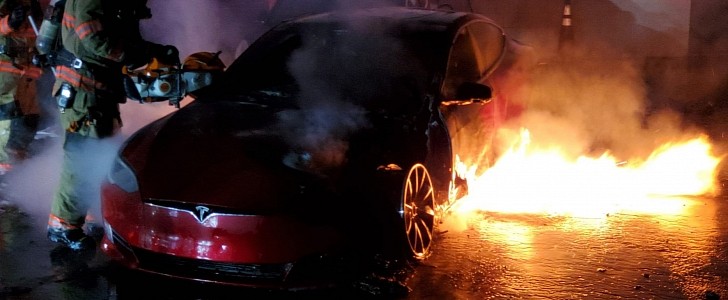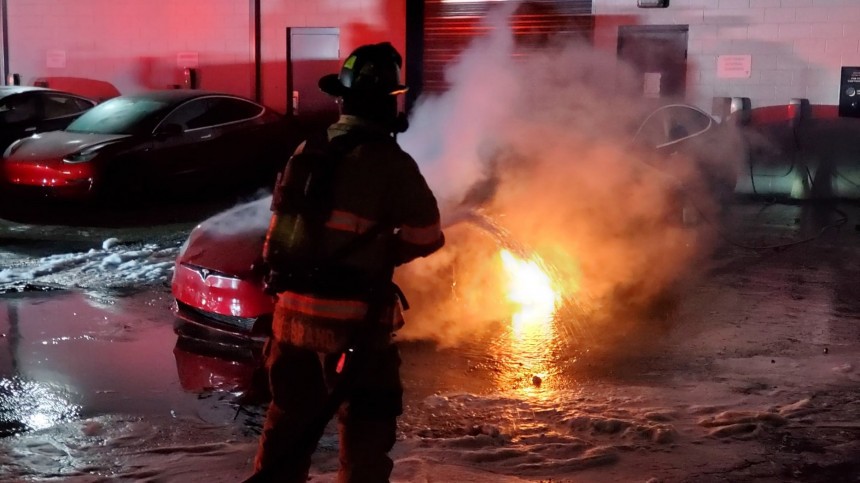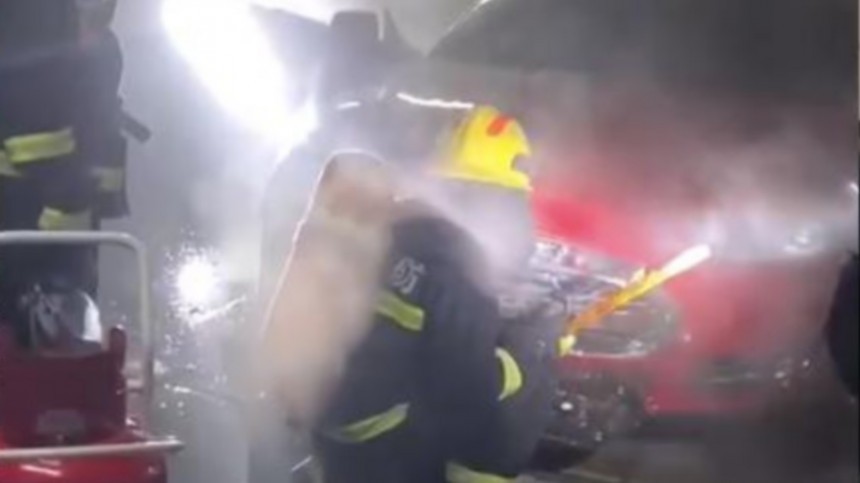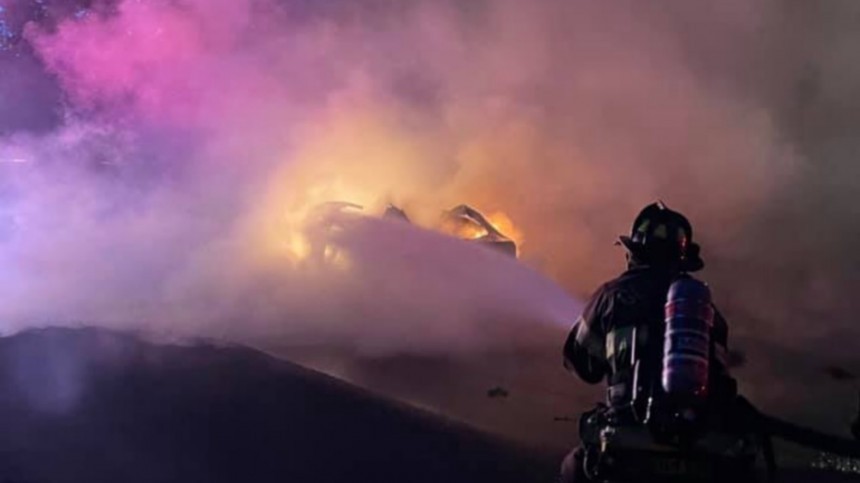NHTSA has been accused multiple times of being too slow or too lenient with car manufacturers – or both. The organization’s latest answer on an investigation petition will raise even more criticism based on the same principles: speed and accuracy. NHTSA denied a request to investigate Tesla battery packs due to a possible fire risk.
The petition was filed on September 17, 2019. In that petition, Edward C. Chen asked the agency to verify why Tesla released the software updates 2019.16.1 and 2019.16.2. The attorney that was responsible for the lawsuit about the same updates accused the company of using them to hide issues with its battery packs that could lead to fires.
On November 2, 2019, NHTSA agreed to proceed with a preliminary evaluation. After almost two years, it denied it on September 28, 2021. The agency said it would not verify the software updates because of “the absence of any incidents in the United States related to fast charging, and the absence of any such incidents globally since May 2019.” Which is incorrect.
Chen made his petition to NHTSA based on his lawsuit, which reported five fires with the Model S. They happened in Los Angeles on June 16, 2018, in Shanghai on April 21, 2019, in San Francisco on May 3, 2019, in Hong Kong on May 12, 2019, and in Ratingen, Germany, on July 30, 2019. The agency refers only to these fires to state “the absence of any such incidents globally since May 2019.”
The problem is that many more fires have occurred with Model S and Model X units since then. On May 22, 2020, a Tesla Model S caught fire in Kaysville, Utah, damaging a Porsche Boxster parked right to its left. On July 8, 2020, a Tesla Model S burst into flames in Coral Gables. On November 24, 2020, a 2015 Tesla Model S caught fire in Frisco, Texas. And there’s more.
On December 30, 2020, two Model S units turned into a massive blaze in San Ramon, California. Only one of them started the incident, according to the firefighters. On June 29, 2021, a brand-new Tesla Model S Plaid burst into flames in Gladwyne, Pennsylvania. Although it probably did not have the voltage-capping software, it has the same battery pack as the affected vehicles.
Last August 22, a Tesla Model S caught fire in Guangzhou, China. On August 28, the same happened to a Model X in a Tesla Service Center in Luxembourg. Finally, on September 27, a Model S demanded firefighters’ attention in the back of the Tesla Service Center in Marietta, Georgia. These are only the cases we have covered: there might be more that nobody talked about.
According to NHTSA, the software updates 2019.16.1 and 2019.16.2 were a “voltage limiting firmware” with “a dynamic algorithm that is enabled in vehicles with high Supercharging use histories, which contributes to high usage stress to the high-voltage (HV) battery.” Considering the agency requested a lot of information from Tesla, this is probably what the company told it about its OTA updates.
Due to how they would work, these updates would have “been enabled in approximately 2,062 vehicles.” NHTSA received 59 complaints about range reduction (52) and lowered charging speeds (7) “through December 2020.” Of these 52 complaints about less range, only 58% (30 of 52) would have been caused by the voltage-capping update. NHTSA did not disclose what caused issues on the other 42% – probably because Tesla did not inform the agency about that.
We have asked NHTSA nine questions about the situation. It is not clear why it did not investigate cases that emerged after the petition and stuck only to the five incidents the lawsuit presented. In two of these five cases, the agency said that “the origin of the fire was external to the HV battery.” The one in Germany would be among the two, but NHTSA did not state where that information came from.
NHTSA also said that the vehicles that caught fire “had histories of high-stress usage for the HV batteries,” a piece of information that probably came from Tesla. This high stress came from “high Supercharging use histories.” By denying the investigation, NHTSA decided to ignore the effects this high use could have on battery packs. We also asked it why. It told us it had “no further comment beyond” the closing resume.
Although NHTSA said that the decision “does not foreclose the agency from taking further action,” this is not what affected customers expected to hear. The investigation it denied would be the last hope to understand what happened in these multiple fire episodes.
Tesla did not explain why it released the voltage-capping updates, and it has no plans to do that in court. The company is currently trying to settle the lawsuit started by Chen by offering compensation to the plaintiffs. If they accept it – and there’s a good chance they will – the money and NDAs (non-disclosure agreements) Tesla will want them to sign will bury the subject for good, regardless of new blazes that may still happen. As useless as that now seems to be, we’ll keep reporting them.
On November 2, 2019, NHTSA agreed to proceed with a preliminary evaluation. After almost two years, it denied it on September 28, 2021. The agency said it would not verify the software updates because of “the absence of any incidents in the United States related to fast charging, and the absence of any such incidents globally since May 2019.” Which is incorrect.
Chen made his petition to NHTSA based on his lawsuit, which reported five fires with the Model S. They happened in Los Angeles on June 16, 2018, in Shanghai on April 21, 2019, in San Francisco on May 3, 2019, in Hong Kong on May 12, 2019, and in Ratingen, Germany, on July 30, 2019. The agency refers only to these fires to state “the absence of any such incidents globally since May 2019.”
On December 30, 2020, two Model S units turned into a massive blaze in San Ramon, California. Only one of them started the incident, according to the firefighters. On June 29, 2021, a brand-new Tesla Model S Plaid burst into flames in Gladwyne, Pennsylvania. Although it probably did not have the voltage-capping software, it has the same battery pack as the affected vehicles.
Last August 22, a Tesla Model S caught fire in Guangzhou, China. On August 28, the same happened to a Model X in a Tesla Service Center in Luxembourg. Finally, on September 27, a Model S demanded firefighters’ attention in the back of the Tesla Service Center in Marietta, Georgia. These are only the cases we have covered: there might be more that nobody talked about.
Due to how they would work, these updates would have “been enabled in approximately 2,062 vehicles.” NHTSA received 59 complaints about range reduction (52) and lowered charging speeds (7) “through December 2020.” Of these 52 complaints about less range, only 58% (30 of 52) would have been caused by the voltage-capping update. NHTSA did not disclose what caused issues on the other 42% – probably because Tesla did not inform the agency about that.
We have asked NHTSA nine questions about the situation. It is not clear why it did not investigate cases that emerged after the petition and stuck only to the five incidents the lawsuit presented. In two of these five cases, the agency said that “the origin of the fire was external to the HV battery.” The one in Germany would be among the two, but NHTSA did not state where that information came from.
Although NHTSA said that the decision “does not foreclose the agency from taking further action,” this is not what affected customers expected to hear. The investigation it denied would be the last hope to understand what happened in these multiple fire episodes.
Tesla did not explain why it released the voltage-capping updates, and it has no plans to do that in court. The company is currently trying to settle the lawsuit started by Chen by offering compensation to the plaintiffs. If they accept it – and there’s a good chance they will – the money and NDAs (non-disclosure agreements) Tesla will want them to sign will bury the subject for good, regardless of new blazes that may still happen. As useless as that now seems to be, we’ll keep reporting them.

























